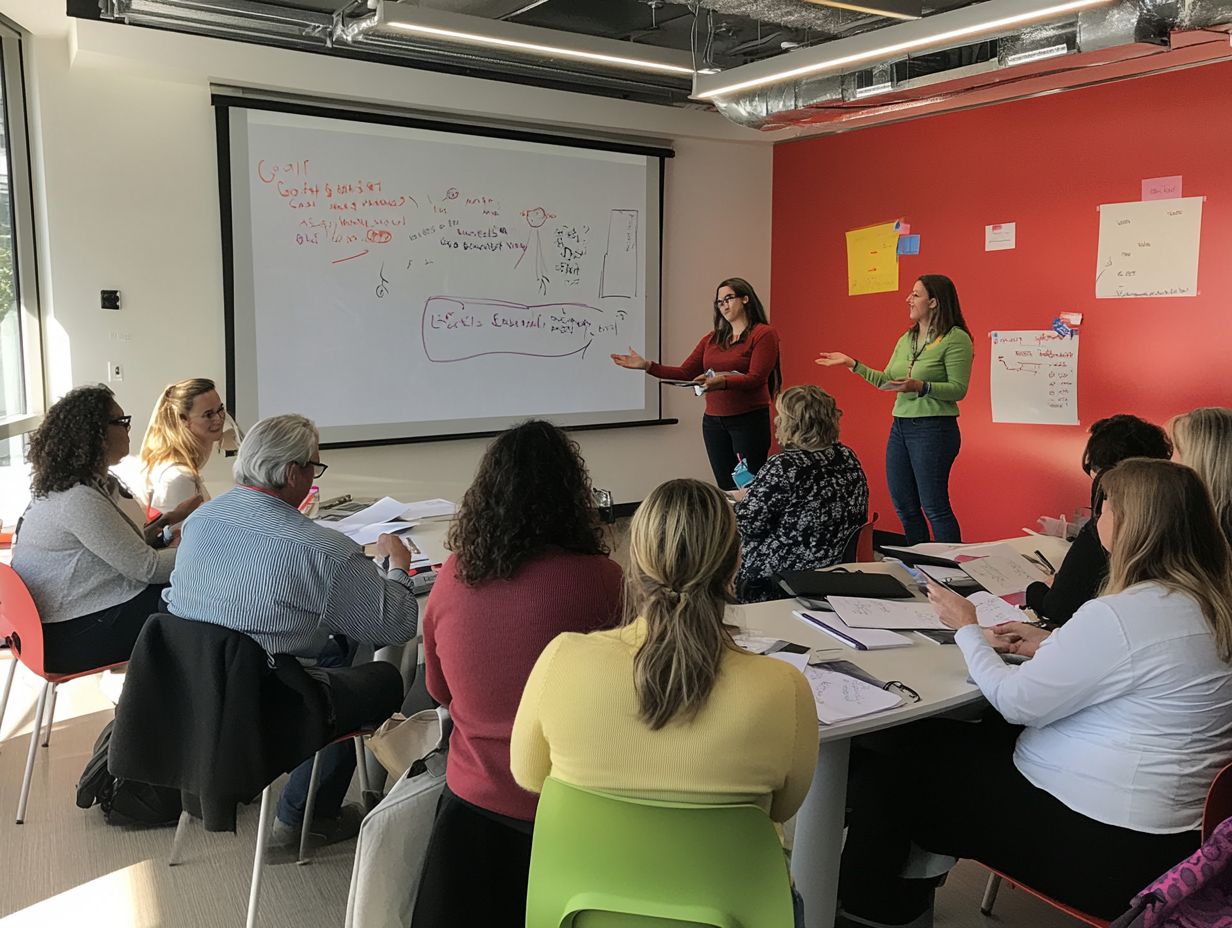What Are the Key Elements of Effective Training?
Training is a pivotal element in personal and professional development, but not every training program delivers the outcomes you seek.
What truly makes training effective? This discussion reveals essential components that foster impactful training: clear objectives, engaging content, and relevant exercises that resonate with participants.
Explore actionable strategies to integrate these elements and learn how to assess the success of your training initiatives. Start transforming your training today for real results that matter.
Contents
- Key Takeaways:
- What Makes Training Truly Effective?
- Key Elements of Effective Training
- Implementing Effective Training
- Measuring the Success of Effective Training
- Frequently Asked Questions
- What are the key elements of effective training?
- Why is having a well-defined goal important in training?
- What role does relevant content play in effective training?
- How can engaging delivery enhance the effectiveness of training?
- Why is practical application important in training?
- How does evaluation contribute to effective training?
- What is the importance of continuous improvement in training?
Key Takeaways:

- Clear objectives help guide learning and ensure you achieve your goals.
- Engaging and interactive content keeps learners motivated and promotes active participation.
- Practical exercises and feedback are crucial for applying knowledge in real-world scenarios.
What Makes Training Truly Effective?
Effective training means having a clear and smart plan to boost employee skills through meticulously designed programs tailored to meet specific learning needs and organizational goals.
It includes various training methods, such as digital training, practical assessments, and continuous learning initiatives, ensuring you acquire the necessary skills to excel in your role.
In today s corporate landscape, effective training is essential for cultivating a culture of learning and innovation within your organization, leading to increased employee engagement and retention.
Key Elements of Effective Training
Key elements of effective training ensure your programs meet their objectives while fostering learner engagement. Understanding what makes a successful corporate training program is crucial for supporting your organization’s goals regarding employee development and performance enhancement.
Focus on clear objectives that guide learning, engaging content that captivates your audience, and relevant exercises that enhance practical application. To achieve this, consider exploring what training tools are most effective, as incorporating effective feedback mechanisms and providing consistent support will significantly contribute to the success of your corporate training initiatives.
Clear Objectives and Goals
Establishing clear objectives and goals is crucial in designing effective training programs. These objectives serve as a roadmap, guiding both trainers and learners to understand expectations and competencies that need to be achieved.
When you align these training objectives with your organization’s broader goals, you enhance individual skills and contribute to the company’s overall success. By prioritizing skills assessment in formulating these objectives, you ensure employees gain the competencies needed to tackle current and future challenges.
This alignment motivates learners, boosting their engagement and retention of knowledge. It also provides a framework for evaluating progress and effectiveness, ultimately leading to improved performance and greater job satisfaction.
Engaging and Interactive Content
Engaging and interactive content is a cornerstone of effective training, enhancing learner engagement and knowledge retention through innovative techniques like using game-like elements in training to make learning fun and mobile learning.
By incorporating elements such as quizzes, challenges, and interactive simulations, you boost motivation and create a spirited sense of competition. Utilizing game-like techniques transforms traditional educational experiences into vibrant environments where participants actively engage in their own learning journey.
Mobile learning adds convenience, granting flexibility to access training materials anytime and anywhere, ensuring you stay connected and engaged. These contemporary strategies not only captivate learners but also accommodate various learning styles, ensuring your training content resonates beyond conventional methods.
Relevant and Practical Exercises

Incorporating relevant and practical exercises into your training programs significantly enhances how well you learn. This approach allows you to apply theoretical knowledge in real-world scenarios, effectively addressing any skills gaps identified during the training assessment phase.
These hands-on activities not only reinforce your learning objectives but also provide immediate feedback. This creates an environment ripe for continuous improvement. When you engage in simulations or case studies, you gain the confidence to tackle challenges that may arise on the job.
By aligning these practical tasks with specific competencies, you can ensure that skill development is targeted and bridges any identified gaps. Ultimately, integrating practical exercises transforms training from a passive experience into an interactive journey. This reinforces a culture of growth and adaptability that is essential in today’s rapidly changing work environment.
Effective Feedback and Evaluation
Effective feedback and evaluation mechanisms are vital for you to measure the effectiveness of your training programs. They ensure you receive helpful feedback on your performance and learning progress throughout the training journey.
This process involves systematically assessing various training metrics, such as how well you remember what you’ve learned and the practical application of the skills you’ve acquired. By doing so, you gain a comprehensive overview of your development.
Engaging in regular check-ins and utilizing both qualitative and quantitative data enables you to create a robust feedback loop. This approach helps you spot ways to improve and grow, cultivating a culture of growth and continuous learning.
Tailoring evaluations to your individual learning style enhances the training’s impact, ultimately leading to greater satisfaction and productivity on your part.
Consistent and Ongoing Support
Consistent and ongoing support from leadership is crucial for sustaining your development and reinforcing the principles you’ve learned during training programs. This support fosters a culture of continuous learning within your organization.
When leaders commit to keeping communication lines open and actively engage with their teams, they cultivate an environment where you feel enabled to embrace new skills and apply them effectively. This guidance not only enhances the immediate benefits of corporate training but also nurtures your long-term professional growth.
Such an approach clearly demonstrates that leadership values continuous improvement, which in turn inspires you to pursue your own development goals with enthusiasm and confidence.
Implementing Effective Training
Implementing effective training demands a strategic approach that includes developing robust training initiatives, integrating cutting-edge learning tools, and aligning your training strategies with organizational objectives. Act now to enhance employee performance and drive overall success within the organization.
Strategies for Incorporating Key Elements
Adopting effective training strategies is essential for you to develop a robust training framework that addresses the diverse learning needs of your employees while aligning with your organizational goals.
To achieve this, begin by conducting thorough assessments of training needs, which will help you identify skill gaps and areas for improvement. By leveraging various training program design methods, you can create tailored programs that not only enhance knowledge retention but also foster engagement among your team members.
Employing a blend of learning methods such as simulations, on-the-job training, and e-learning will cater to different learning styles, ensuring that everyone can thrive. Take the first step today by assessing your team’s training needs!
Additionally, by regularly gathering feedback and evaluating the effectiveness of your training initiatives, you can maintain a dynamic approach that continually aligns employee development with your business objectives.
Measuring the Success of Effective Training

Measuring the success of effective training is crucial for understanding its impact on employee performance and organizational outcomes. By employing training effectiveness metrics and evaluation methods, you can analyze data and gather valuable employee feedback. This ensures that your training initiatives are not only impactful but also aligned with your organizational goals.
How to Measure Success in Training
Establishing clear metrics and indicators of success is essential to evaluate the effectiveness of training programs and ensure they align with your employee development objectives.
This process involves identifying important measures of success, such as retention rates, employee performance assessments, and engagement levels. By systematically analyzing these metrics, you gain valuable insights into how well the training resonates with participants and its overall impact on productivity.
Utilizing feedback mechanisms, like surveys and interviews, enables you to measure participant satisfaction and pinpoint areas for improvement. These evaluations are your roadmap to success! They highlight what works well and show where you can improve, guiding ongoing enhancements in your employee development strategies.
Frequently Asked Questions
What are the key elements of effective training?
The key elements of effective training include a well-defined goal, relevant content, engaging delivery, practical application, regular evaluation, and the key roles of an effective trainer for continuous improvement.
Why is having a well-defined goal important in training?
Having a clear goal helps focus the training and ensures that it aligns with the needs and objectives of the organization. It also provides direction for the trainer and the trainees.
What role does relevant content play in effective training?

Relevant content ensures that the training is applicable to the trainees’ roles and responsibilities, increasing their understanding and retention of the material.
How can engaging delivery enhance the effectiveness of training?
An engaging delivery captures the attention of trainees and keeps them actively involved in the learning process. This boosts their motivation and participation, leading to better retention of the material.
Why is practical application important in training?
Practical application allows trainees to put their knowledge and skills into practice, reinforcing learning and making it more applicable to their job roles.
How does evaluation contribute to effective training?
Regular evaluation allows trainers to assess the effectiveness of the training and make necessary adjustments. It also provides valuable feedback for both the trainer and trainees to improve future training sessions.
What is the importance of continuous improvement in training?
Continuous improvement ensures that the training program evolves and adapts to the changing needs of the organization and its employees, maintaining its effectiveness and relevance over time.
Start measuring your training success today!





